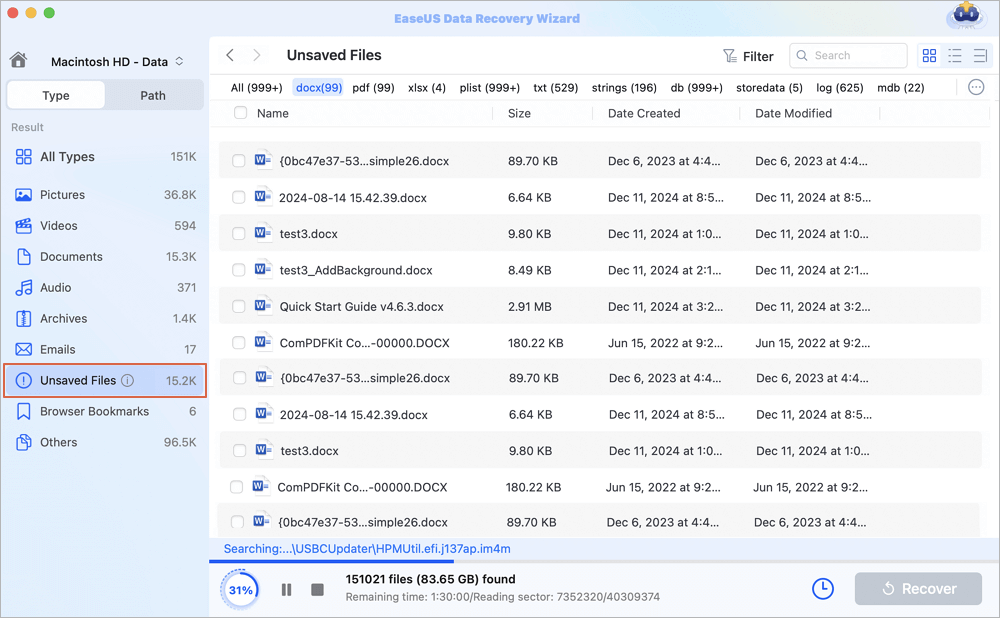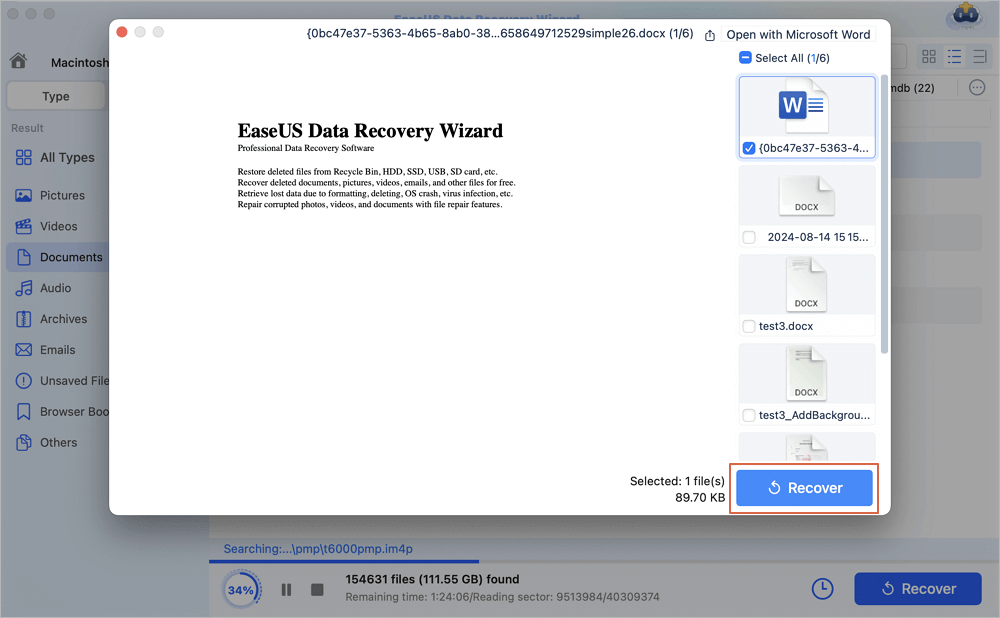Overview of Recovering Unsaved iWork Document
iWork is a general term of the office suite of applications that were created by Apple. It includes Pages, Numbers, and Keynotes. Generally speaking, iWork could be considered as a Mac version of Microsoft Office.
If users are working on their iWork documents, but a sudden computer shut down happens, there will be no time left for them to save the document. So that's why users want to know how to recover files lost in this situation.

How to Recover Unsaved iWork Document
After checking all claimed working methods, we finally find two solutions that can really recover unsaved iWork documents. But both of these two methods have a precondition: You must have already given the document a name and saved it on your Mac before data loss. If you didn't, then there will be no way for you to retrieve your unsaved document, no matter how other guides brag about their data recovery ability.
Method 1. Recover Unsaved iWork Document from Autosave Folder
Autosave is a built-in feature of Mac iWork applications, once you have enabled this feature, it would automatically save your iWork documents at least once per hour. And when you opened, duplicated, locked, renamed, reverted your document, automatically save will also occur. Follow the steps below to see how to recover unsaved iWork document from the Autosave folder, including Pages autosave. Here we will take the Numbers document as an example.
Step 1. Go to the Autosave folder location: [Your hard drive] > Users > [your home folder] > Library > Containers > com.apple.iWork.Numbers.
Step 2. Right-click the "com.apple.iWork.Numbers." file, and select "Show Package Contents".
Step 3. Find Data > Library > Autosave information. Here store all the autosave files, check if the one you want to recover is in it.
Method 2. Recover Unsaved iWork Document with EaseUS Data Recovery Wizard
If you can't find the wanted files in the Autosave folder, or you didn't enable the Autosave feature, then you can try a third-party data recovery tool - EaseUS Data Recovery Wizard for Mac. It is specialized in Mac data recovery, no matter your data lost because of accidental deletion, system crash, or partition loss, EaseUS Mac data recovery software would help you get it back.
Recently, EaseUS Data Recovery Wizard for Mac updated with a new feature, which is to recover unsaved iWork documents as well as Microsoft Office documents. If you want to find back your unsaved data, follow the step-by-step guide below to have a try.
Download EaseUS Data Recovery Wizard for Mac Here:
Step 1. Select the disk
Launch EaseUS Data Recovery Wizard for Mac, hover the mouse over the device where you lost an unsaved file, and click "Search for lost files".

Step 2. Choose unsaved documents
After the scan, click "Type", and expand "Unsaved Documents". Click the exact file type - Word, Excel, Powerpoint, Keynote, Pages, or Numbers you lost without saving.

Step 3. Preview and recover unsaved files
Double-click to preview your unsaved file, select the right version and click "Recover" to save the file to another secure location on Mac.

All You Should Know About iWork Recovery
Here we will tell you some must-know tips about iWork recovery. If you are confused with data recovery on Mac, this part might help you a little.
1. Where do I find autosave files on Mac?
One crucial problem that bothers most Mac users when they want to recover data is "Where do I find autosave files on Mac?" Here we have listed all the answers:
For Microsoft Word:
AutoSave folder location: ~/Library/Containers/com.microsoft.Word/Data/Library/Preferences/AutoRecovery
For Microsoft Excel and PowerPoint files, you just need to change the word "Word" to "Excel" or "PowerPoint".
For iWork Numbers:
Autosave folder location: [Your hard drive] > Users > [your home folder] > Library > Containers > com.apple.iWork.Numbers > Data > Library > Autosave information
For other iWork documents, such as Pages and Keynotes, you just need to change the word "Numbers" to the corresponding name.
2. Can Time Machine Recover Unsaved Files?
There are a lot of tech guides that claim that users can try to recover unsaved files from their Time Machine backup. Well, can they? Actually, you can't recover the unsaved files from your Time Machine backup. The reason why you can't do it is that Time Machine backups are saved in your Mac hard drive, while the unsaved files only exist in RAM. Time Machine can only help when you need to recover deleted files on Mac.
Was This Page Helpful?
Brithny is a technology enthusiast, aiming to make readers' tech lives easy and enjoyable. She loves exploring new technologies and writing technical how-to tips. In her spare time, she loves sharing things about her game experience on Facebook or Twitter.
Jean is recognized as one of the most professional writers in EaseUS. She has kept improving her writing skills over the past 10 years and helped millions of her readers solve their tech problems on PC, Mac, and iOS devices.
-
EaseUS Data Recovery Wizard is a powerful system recovery software, designed to enable you to recover files you’ve deleted accidentally, potentially lost to malware or an entire hard drive partition.
Read More -
EaseUS Data Recovery Wizard is the best we have seen. It's far from perfect, partly because today's advanced disk technology makes data-recovery more difficult than it was with the simpler technology of the past.
Read More -
EaseUS Data Recovery Wizard Pro has a reputation as one of the best data recovery software programs on the market. It comes with a selection of advanced features, including partition recovery, formatted drive restoration, and corrupted file repair.
Read More
Related Articles
-
10 Steps to Fix "There is No Connected Camera" on Macbook Air/Pro/iMac 2025
![author icon]() Jean/Dec 12, 2025
Jean/Dec 12, 2025 -
Top 11 Tools to Recover Deleted Partitions on Mac
![author icon]() Daisy/Dec 15, 2025
Daisy/Dec 15, 2025 -
SD Card Not Reading on a Mac? 7 Solutions Without Data Loss!
![author icon]() Brithny/Dec 14, 2025
Brithny/Dec 14, 2025 -
Battle of Hard Drives: Fusion Drive vs. SSD vs. HDD. Which Is Better?
![author icon]() Cedric/Dec 12, 2025
Cedric/Dec 12, 2025